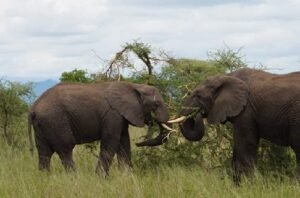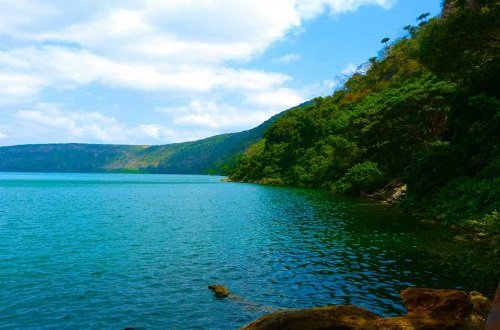Tarangire National Park – Tanzania’s Hidden Safari Gem in Africa
When travelers think of Tanzania, names like the Serengeti and Ngorongoro Crater often come to mind. Yet, tucked quietly in the northern part of the country lies a hidden treasure that embodies the very soul of Africa — Tarangire National Park. Known for its breathtaking landscapes, ancient baobab trees, and massive elephant herds, Tarangire is one of Tanzania’s most captivating safari destinations.
Spanning about 2,850 square kilometers (1,100 square miles), Tarangire National Park forms part of Tanzania’s Northern Safari Circuit, which also includes Serengeti, Ngorongoro, and Lake Manyara. Despite being less crowded, it offers an equally rich safari experience — making it a perfect destination for those seeking both adventure and serenity in Africa’s wild heart.

A Brief History and Overview
Tarangire National Park was established in 1970 and takes its name from the Tarangire River, which flows through the park. This river serves as the lifeline of the ecosystem, attracting animals from miles away during the dry season.
The park’s landscape is a photographer’s dream — a mosaic of rolling hills, golden grasslands, acacia woodlands, and towering baobabs that seem to whisper stories from centuries past. It’s a place where wildlife thrives in harmony with nature’s rhythm, and each day brings a new scene of beauty and survival.
The Magical Landscape
One of the most striking features of Tarangire is its ancient baobab trees, often called “the trees of life.” These giants dominate the scenery, creating a surreal backdrop for wildlife sightings and photography. Some of these trees are estimated to be over 1,000 years old, their enormous trunks storing water to survive long dry spells.
During the dry season (June to October), the Tarangire River becomes a magnet for wildlife, drawing thousands of animals in search of water. The contrast between the green vegetation near the river and the dry, golden plains beyond creates a stunning visual display — nature’s own painting in motion.
A Wildlife Haven
Tarangire may be smaller than the Serengeti, but its wildlife diversity is astonishing. It’s often said that during the dry season, Tarangire has one of the highest concentrations of animals outside the Serengeti ecosystem.
1. The Elephant Kingdom
Tarangire is famous for having the largest elephant population in northern Tanzania. Herds of up to 300 elephants can often be seen roaming the park, bathing in the river, or gathering beneath the shade of baobab trees. Watching these gentle giants interact is one of the most memorable experiences any safari-goer can have.
2. Big Cats and Predators
Lions are frequently spotted lounging on termite mounds or stalking prey along the riverbanks. Cheetahs roam the open plains, while leopards prefer the wooded areas where they can ambush from the trees. Hyenas, jackals, and even the rare African wild dog occasionally make appearances.
3. Grazers and Giants
Tarangire hosts vast numbers of wildebeest, zebras, buffaloes, impalas, gazelles, and giraffes. The sight of giraffes gracefully feeding against the backdrop of baobabs is truly iconic. During the dry season, animals from surrounding regions migrate into Tarangire, creating a wildlife spectacle that rivals any in Africa.
4. Birdwatcher’s Paradise
For bird lovers, Tarangire is a dream come true. The park boasts over 550 bird species, making it one of the top birding destinations in East Africa. Look out for colorful species such as lilac-breasted rollers, yellow-collared lovebirds, ostriches, hornbills, and the impressive Kori bustard — Africa’s heaviest flying bird.

Best Things to Do in Tarangire National Park
Tarangire is more than just a game drive destination. It offers a variety of activities that allow visitors to experience the park’s magic from different perspectives.
1. Game Drives
Morning and evening game drives are the best ways to explore the park’s rich wildlife and scenic beauty. Early morning drives often provide dramatic sightings of predators returning from a night’s hunt, while sunset drives offer stunning golden light for photography.
2. Walking Safaris
Guided walking safaris, led by armed rangers, allow visitors to experience the wilderness up close. You’ll learn to identify animal tracks, insects, and plants while gaining a new appreciation for the smaller details of the ecosystem.
3. Night Game Drives
For those staying in private concessions around the park, night drives reveal Tarangire’s nocturnal residents — from bush babies and genets to lions on the prowl. The experience is thrilling and gives you a glimpse of a completely different side of the African bush.
4. Birdwatching Tours
With its diverse habitats — swamps, woodlands, and rivers — Tarangire is perfect for birding. The best time for birdwatching is during the wet season (November to May), when migratory birds join the resident species.
5. Cultural Visits
Nearby Maasai and Barabaig villages welcome visitors to learn about their traditions, lifestyle, and relationship with the land. These experiences offer an enriching cultural dimension to your safari.
The Best Time to Visit Tarangire National Park
Tarangire is a year-round destination, but the experience changes with the seasons.
- Dry Season (June – October): This is the best time for wildlife viewing, as animals gather around the Tarangire River. The vegetation is sparse, making animals easier to spot.
- Wet Season (November – May): The landscape turns lush and green, ideal for birdwatching and photography. While some roads may be muddy, the park is quieter and more serene.
Even during the wet months, the park’s beauty and peaceful atmosphere make it worth visiting.
Accommodation Options
Tarangire offers a wide range of accommodations catering to all budgets and styles:
- Luxury Lodges: Such as Tarangire Treetops Lodge and Sanctuary Swala Camp, offering high-end comfort, gourmet dining, and views overlooking waterholes.
- Mid-Range Lodges: Tarangire Safari Lodge and Maramboi Tented Camp are popular choices, combining comfort and proximity to wildlife.
- Budget and Camping: Public campsites and budget-friendly tented camps provide a more adventurous experience for backpackers and nature lovers.
Many lodges are designed to blend seamlessly with the environment, allowing guests to enjoy wildlife right from their verandas.
How to Get There
Tarangire National Park is located approximately 118 kilometers (73 miles) southwest of Arusha, Tanzania’s main safari hub.
- By Road: The drive from Arusha takes about 2–3 hours along well-maintained roads. It’s often included as part of the Northern Safari Circuit itinerary.
- By Air: Charter flights are available from Arusha, Serengeti, or Ngorongoro to the park’s Kuro Airstrip, offering stunning aerial views of the landscape.
Most visitors explore Tarangire as part of a combined safari route with Lake Manyara, Ngorongoro Crater, and Serengeti National Park.
Why Tarangire is One of the Best Parks in Africa
What sets Tarangire apart is its peaceful atmosphere and authentic safari feel. Unlike busier parks, Tarangire allows you to enjoy wildlife encounters in solitude, surrounded by timeless African scenery.
Its vast elephant herds, iconic baobab trees, and rich birdlife make it one of the most visually captivating parks in Africa. The park also serves as a vital migration corridor for animals moving between ecosystems, ensuring a dynamic and ever-changing experience for visitors.
In Tarangire, every moment feels personal — from watching elephants splash in the river to witnessing sunsets that paint the sky in shades of orange and gold.
Tarangire National Park is truly one of Tanzania’s best-kept secrets and one of Africa’s most enchanting safari destinations. Its untouched landscapes, thriving wildlife, and ancient trees create an atmosphere of raw, untamed beauty that lingers long after you leave.
Whether you’re a first-time safari-goer or a seasoned traveler, Tarangire promises a deep connection with nature and memories that last a lifetime.
So next time you plan your Tanzanian adventure, don’t just chase the famous parks — make sure to include Tarangire. You’ll discover a peaceful, majestic corner of Africa where nature still reigns supreme.



